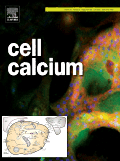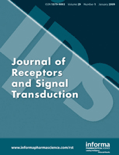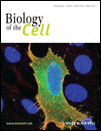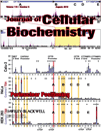
CELL CALCIUM
Scope & Guideline
Exploring Calcium's Impact on Health and Disease
Introduction
Aims and Scopes
- Calcium Signaling Mechanisms:
Research on the molecular mechanisms underlying calcium signaling pathways, including store-operated calcium entry (SOCE), calcium release from intracellular stores, and the role of various calcium channels. - Calcium in Disease:
Investigations into how dysregulation of calcium signaling contributes to various diseases, including cancer, neurodegenerative disorders, and cardiovascular diseases. - Technological Advances in Calcium Imaging:
Development and application of innovative imaging techniques and tools for monitoring intracellular calcium dynamics in live cells. - Calcium and Cellular Function:
Studies on the role of calcium in various cellular processes such as cell migration, secretion, muscle contraction, and neuronal activity. - Interorganellar Calcium Communication:
Exploration of calcium signaling between different organelles, such as the endoplasmic reticulum and mitochondria, and their impact on cellular homeostasis. - Calcium-Dependent Proteins:
Research on proteins that interact with calcium, including calmodulin and S100 proteins, and their roles in cellular signaling and regulation.
Trending and Emerging
- Calcium and Cancer:
An increasing number of studies focus on the role of calcium signaling in cancer progression, metastasis, and therapeutic resistance, indicating a growing interest in targeting calcium pathways for cancer treatment. - Calcium in Neurodegenerative Diseases:
Research on calcium's involvement in neurodegenerative conditions, particularly Alzheimer's disease, has surged, reflecting an emphasis on understanding how calcium dysregulation contributes to neuronal death and dysfunction. - Mechanosensitive Calcium Channels:
Emerging studies investigate the role of mechanosensitive calcium channels in various physiological processes, indicating a trend towards understanding how mechanical stimuli influence calcium signaling. - Technological Innovations in Calcium Research:
There is a growing focus on developing advanced imaging and genetic tools for studying calcium dynamics, including genetically encoded calcium indicators and high-resolution imaging techniques. - Calcium in Immune Responses:
Research examining how calcium signaling regulates immune cell function and responses to pathogens is increasing, highlighting the intersection of calcium biology with immunology.
Declining or Waning
- General Calcium Homeostasis:
Earlier publications often focused on broad aspects of calcium homeostasis without specific disease context. Recent studies have shifted towards more targeted investigations into calcium's role in specific diseases or cellular mechanisms. - Non-Cellular Contexts of Calcium:
Research involving calcium's role outside of cellular signaling, such as its environmental or systemic effects, has become less prevalent compared to direct cellular studies. - Calcium in Muscle Physiology:
While muscle physiology was a significant focus in earlier issues, studies specifically dedicated to calcium's role in muscle contraction and regulation have decreased as research has expanded into other areas. - Calcium and Metabolism:
Publications that broadly discuss calcium's role in metabolism without a strong link to cellular signaling mechanisms are less frequently encountered in recent issues.
Similar Journals

CELLULAR & MOLECULAR BIOLOGY LETTERS
Unlocking the Secrets of Life at the Molecular LevelCELLULAR & MOLECULAR BIOLOGY LETTERS, published by BMC, is a premier open-access journal dedicated to disseminating high-quality research in the fields of Biochemistry, Cell Biology, and Molecular Biology. Established in 1996, the journal has emerged as a leader in its domain, boasting an impressive Q1 ranking across three critical categories as of 2023, reflecting its significant impact within the scientific community. With an ISSN of 1425-8153 and an E-ISSN of 1689-1392, it offers accessible research findings to a global audience, having been open access since 2013. Situated in the United Kingdom, at CAMPUS, 4 CRINAN ST, LONDON N1 9XW, the journal continues to serve as a vital resource for researchers, professionals, and students, contributing to advancements in the understanding of cellular and molecular processes. By providing a platform for original research, reviews, and short communications, CELLULAR & MOLECULAR BIOLOGY LETTERS plays a crucial role in fostering dialogue and collaboration within the scientific community.

JOURNAL OF RECEPTORS AND SIGNAL TRANSDUCTION
Advancing the Frontiers of Receptor BiologyJOURNAL OF RECEPTORS AND SIGNAL TRANSDUCTION, published by TAYLOR & FRANCIS LTD, is a premier academic journal dedicated to advancing our understanding of receptor biology and signal transduction mechanisms. With an ISSN of 1079-9893 and an E-ISSN of 1532-4281, this journal has maintained a reputable standing since its inception in 1980, continually addressing pivotal topics in biochemistry, cell biology, and molecular biology. As evidenced by its 2023 Scopus rankings, which place it in the 64th percentile for Biochemistry and Genetics and Molecular Biology, JOURNAL OF RECEPTORS AND SIGNAL TRANSDUCTION remains a vital source for cutting-edge research, providing insights that are essential for both academic and practical applications. Although the journal currently offers limited open access options, it stands out in the Q2 and Q3 quartiles of its respective categories, making it an invaluable resource for researchers, professionals, and students aiming to stay abreast of the latest findings and methodologies in receptor and signaling research. The journal's commitment to disseminating high-quality research underscores its significance within the scientific community, fostering innovation and collaboration across disciplines.

BIOLOGY OF THE CELL
Innovating research at the core of life sciences.BIOLOGY OF THE CELL is a prominent academic journal published by Wiley, dedicated to advancing the field of cellular biology through the dissemination of innovative research and insights. With its ISSN (0248-4900) and E-ISSN (1768-322X), this journal has been a vital resource since its inception in 1981 and is set to continue its scholarly contributions until 2024. Positioned within the Q3 quartile in Cell Biology and Q2 in Medicine (miscellaneous) as of 2023, BIOLOGY OF THE CELL is recognized for its rigorous peer-review process and its commitment to high-quality publication in critical areas such as biochemistry, genetics, and molecular biology. Although the journal does not currently offer open access options, it remains accessible through the Wiley platform, ensuring that researchers, professionals, and students can benefit from its rich repository of knowledge. By linking fundamental cellular processes with broader medical implications, this journal serves as a critical platform for fostering dialogue and innovation in cellular research, making it an essential read for anyone engaged in the life sciences.

Biochemistry Moscow Supplement Series A-Membrane and Cell Biology
Advancing Knowledge in Cell Biology and BiochemistryBiochemistry Moscow Supplement Series A-Membrane and Cell Biology, published by PLEIADES PUBLISHING INC in the United States, is a pivotal journal in the fields of biochemistry, biophysics, and cell biology. Established in 2008, this journal has become a significant platform for disseminating novel research findings and reviews, fostering advanced studies in membrane dynamics and cellular processes. Although currently ranked in the Q4 quartile across its categories, the journal provides researchers and professionals with open access to a wealth of knowledge, helping to bridge gaps in understanding complex biochemical mechanisms. The journal’s commitment to quality and relevance is evident as it continues to contribute to the academic community through its coverage of innovative and emerging topics in cell and membrane biology. Researchers, practitioners, and students alike will find this resource invaluable for keeping abreast of the latest developments in the ever-evolving landscape of biochemistry and cellular research.

Cell Communication and Signaling
Pioneering Research in Biochemical PathwaysCell Communication and Signaling is a premier peer-reviewed journal published by BMC that has made significant contributions to the fields of biochemistry, cell biology, and molecular biology since its establishment in 2003. As an open access journal, it offers unrestricted access to high-quality research, fostering collaboration and innovation among scientists around the globe. The journal is distinguished by its Q1 ranking in all three relevant categories for 2023, underscoring its critical role in advancing the understanding of cellular communication mechanisms and signaling pathways. Positioned within the United Kingdom, Cell Communication and Signaling has been an invaluable resource for researchers, professionals, and students alike, ensuring that the latest findings are accessible to a diverse range of audiences. With an impressive Scopus ranking—placing it in the top percentiles within its subject areas—this journal continues to set the standard for excellence in the pursuit of understanding complex cellular interactions.

HISTOCHEMISTRY AND CELL BIOLOGY
Bridging the Gap Between Histochemistry and Molecular InsightsHISTOCHEMISTRY AND CELL BIOLOGY, published by SPRINGER, is a prominent journal dedicated to advancing the fields of histochemistry and cell biology. With an ISSN of 0948-6143 and an E-ISSN of 1432-119X, this journal has carved a significant niche since its inception in 1995, striving for excellence in research dissemination through a rigorous peer-review process. The journal's impact is reflected in its strong performance across various academic categories, achieving a Q1 ranking in Medical Laboratory Technology, Q2 in Histology, and maintaining a credible presence in Cell and Molecular Biology. Nestled in Germany, and with the backing of a reputable publisher, HISTOCHEMISTRY AND CELL BIOLOGY serves as a pivotal platform for researchers, professionals, and students, fostering innovations that push the boundaries of our understanding of cellular processes. While the journal is not open access, it offers subscription-based access options ensuring comprehensive coverage of crucial findings in the rapidly evolving arena of cell biology and histochemistry.

JOURNAL OF CELLULAR BIOCHEMISTRY
Fostering Excellence in Cellular Biochemistry ResearchJournal of Cellular Biochemistry is a premier academic journal dedicated to advancing the field of biochemistry and cellular biology. Published by Wiley, this influential journal has a significant impact factor that underscores its relevance and authority within the scientific community. With its ISSN 0730-2312 and E-ISSN 1097-4644, the journal has been on the frontier of research since its inception in 1982, and is expected to continue publishing cutting-edge studies through 2024. As evidenced by its ranking in the 2023 Scopus Quartiles, it holds a rank of Q2 in Biochemistry and Q3 in both Cell and Molecular Biology, placing it among the top tiers of scientific journals in these disciplines. The Journal of Cellular Biochemistry serves as a vital resource for researchers, professionals, and students alike, providing a platform for the dissemination of innovative ideas and findings that shape our understanding of cellular processes and biochemical pathways. Though it does not currently offer Open Access options, its robust peer-review process ensures that each publication meets the highest academic standards, thus solidifying its esteemed position in the landscape of biochemical research.

BMC Molecular and Cell Biology
Advancing the frontiers of molecular and cell biology.BMC Molecular and Cell Biology is a forward-thinking open-access journal published by BMC, specializing in the vital fields of molecular biology and cell biology. Since its inception in 2019, the journal has carved a niche for itself, ranking in the Q3 quartile in both Cell Biology and Molecular Biology categories as of 2023. With an ISSN of N/A and an E-ISSN of 2661-8850, the journal provides a platform for groundbreaking research, high-quality reviews, and innovative methodologies. Situated in the United Kingdom, BMC Molecular and Cell Biology promotes a diverse range of studies, addressing fundamental questions in biology that resonate with both experts and new researchers alike. The journal's commitment to open access ensures that valuable findings are readily available to the global scientific community, fostering collaboration and knowledge-sharing across disciplines. Researchers aiming to contribute to the field of cell and molecular biology will find this journal an indispensable resource for both publishing and staying informed on the latest advances.

Current Opinion in Physiology
Advancing Insights in the Dynamic World of PhysiologyCurrent Opinion in Physiology, published by Elsevier, is a leading journal dedicated to the dynamic field of physiology. With an E-ISSN of 2468-8673, this journal provides a platform for the latest insights and perspectives, reflecting the evolving landscape of physiological research. Operating from the United Kingdom, the journal holds a respectable impact factor and is ranked Q2 in both general physiology and medical physiology categories, highlighting its prominence among the global academic community. With Scopus rankings placing it in the 64th and 60th percentiles within its respective categories, Current Opinion in Physiology serves as an essential resource for researchers, professionals, and students eager to stay informed about innovative theories and emerging trends in physiology. The publication emphasizes high-quality reviews that summarize current knowledge and future directions, ensuring readers gain valuable insights applicable in both clinical and research settings.

Acta Physiologica
Advancing the Frontiers of Physiological ResearchActa Physiologica is a premier, peer-reviewed journal published by WILEY, dedicated to the dissemination of high-quality research across the field of physiology. With an impressive impact factor reflective of its Q1 category ranking in Physiology for 2023, this journal is a vital resource for researchers, professionals, and students alike, seeking to explore the complexities of biological systems. The journal is indexed with a commendable Scopus rank of #18 out of 193 in its category, placing it within the top 10% of its field, which underscores its influence and citation frequency within the academic community. Acta Physiologica publishes a variety of articles that address fundamental physiological concepts, innovative methodologies, and cross-disciplinary research. With its open access options, the journal ensures that cutting-edge knowledge is readily accessible, fostering an environment of collaboration and advancement in the study of physiology. Spanning from 2006 to 2024, the journal continues to be at the forefront of physiological research and education, encouraging the global sharing of knowledge through its comprehensive content.